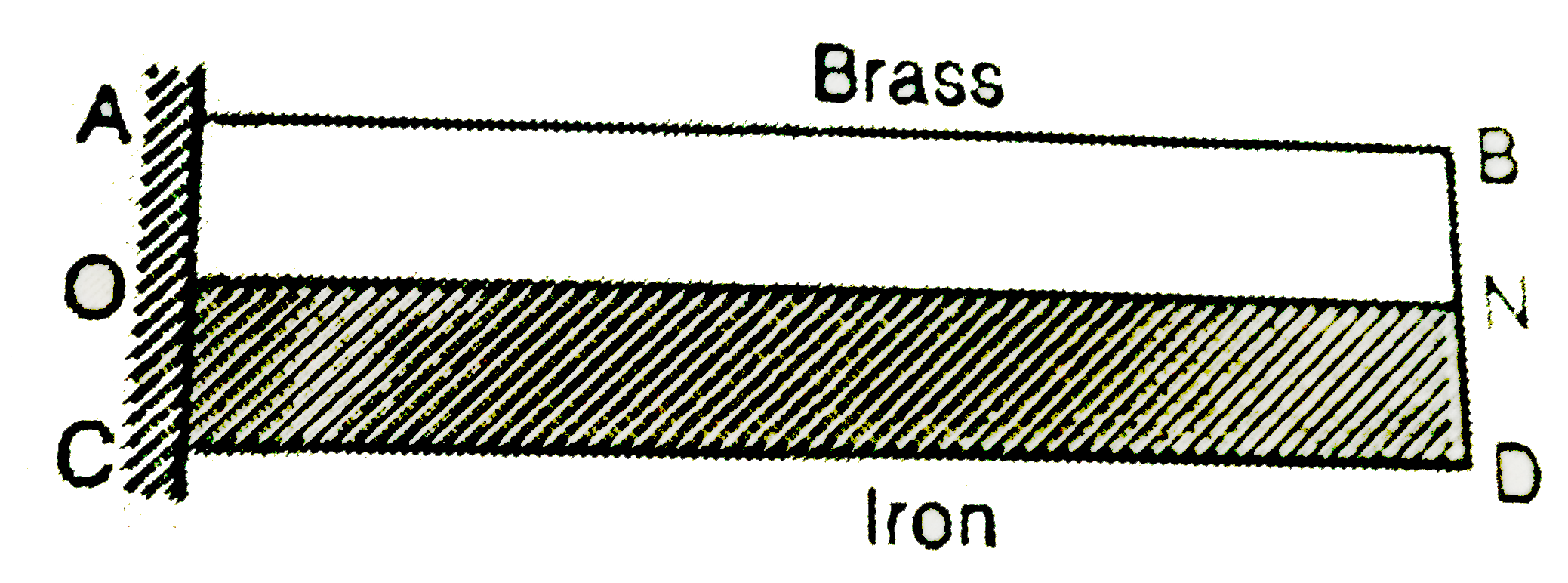A bimetallic strip consiting of a brass strip and a steel strip, each of length 1m and thickness 1/2 cm is clamped at one end at 0∘C.Calculate the depression of the free end when it is heated to 100∘C.

The correct Answer is:4cm
Topper's Solved these Questions
Similar Questions
A bimetallic strip of thickness d and length L is clamped at one end at temperature t1. Find the radius of curvature of the strip if it consists of two different metals of expansivity α1 and α2(α1>α2) when its temperature rises to t2∘C.
View SolutionA bimetallic strip of thickness d and length L is clamped at one end at temperature t1. Find the radius of curvature of the strip if it consists of two different metals of expansivity α1 and α2(α1>α2) when its temperature rises to t2∘C.
View Solution
Knowledge Check
Two thin metal strips, one of brass and the other of iron are fastended together parallel to each other. Thickness of each strip is 2mm. If the strips are of equal length at 0∘C. The radius of the are formed by the bimetaalic strip when heated to 80∘C is (Coefficient of linear expansion of brass=19×10−6/∘C&
of iron=12×10−6/∘C).A3.57mB2.67mC3.12mD4.56mCylinder copper rod of length 1m and a cylinder steel rod of length 1.5m are joined together end to end. The cross sectional area of eac rod is 3.14cm. The free ends of steel rod and copper rods are maintained at 0∘C and 100∘C respectively. The surfaces of rods are thermally insulated. Find the temperature of copper steel junction. (Given thermal conductivity of steel =46J/m−s.∘C and the thermal conductivity of copper =386J/m−s.∘C)
A40∘B60∘C93∘D80.64∘C
A bar of copper of length 75 cm and a bar of steel of length 125 cm are joined together end to end . Both are of circular cross - section with diameter 2 cm . The free ends of the copper and steel bars are maintained at 100∘C and 0∘C respectively . The surface of the bars are thermally insulted . What is the temperature of the copper - steel junction ? What is the heat transmitted per unit time across the junction ? Thermal conductivty of copper 9.2×10−2kcalm−1∘C−1s−1 and that of steel is 1.1×10−2kcalm−1s−1(∘)C−1.
View SolutionA bar of copper of length 75cm and a abr of steel of length 125cm are joined together end to end. Both are of circular cross section with diameter 2cm. The free ends of the copper and the steel bors are maintained at 100∘C and 0^(@)Crespectively.Thecurvedsurfaceofthebors.arethermally∈sa––ted.Wˆisthetemperatureofthecoppe−steeljunction?Wˆistheamountofheattransmiedperunittimeacrossthejunction?Thermalconductivityofcopperis386Js^(-1)m^(-1)^(∘)C−1 and that of steel is 46Js^(-1)m^(-1)(@)C^(-1)
View SolutionA bar of copper of length 75cm and a bar of steel of length 125cm are joined together end to end. Both are of circular cross section with diameter 2cm. The free ends of the copper and the steel bars are maintained at 100∘C and 0∘C respectively. The curved surface of the bars are thermally insulated. What is the temperature of the copper-steel junction? What is the amount of heat transmitted per unit time across the junction? Thermal conductivity of copper is 386Js−1m−1C−1 and that of steel is 46Js−1m−1C−1
View SolutionA brass rod of length 50 cm and diameter 3.0 mm is joined to a steel rod of the same length and diameter. What is the change in length of the combined rod at 250∘C, if the original lengths are at 40.0∘C? Is there a 'thermal stress' developed at the junction ? The ends of the rod are free to expand. Coefficient of linear expansion of brass =2.0×10−5.∘C−1 and that of steel =1.2×10−5.∘C−1.
View SolutionA leveller with one metre long metal strip is used to level the surface of the soil. If the farmer takes the levellr from one end to another end of the field of length 25m, then calculate the area of the field which is levelled.
View SolutionA leveller with one metre long metal strip is used to level the surface of the soil. If the farmer takes the leveller from one end to another end of the field of length 265m hen calculate the area of the field which is levelled.
View Solution
